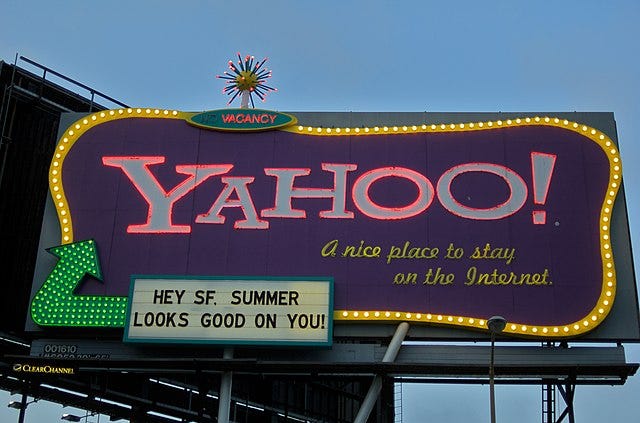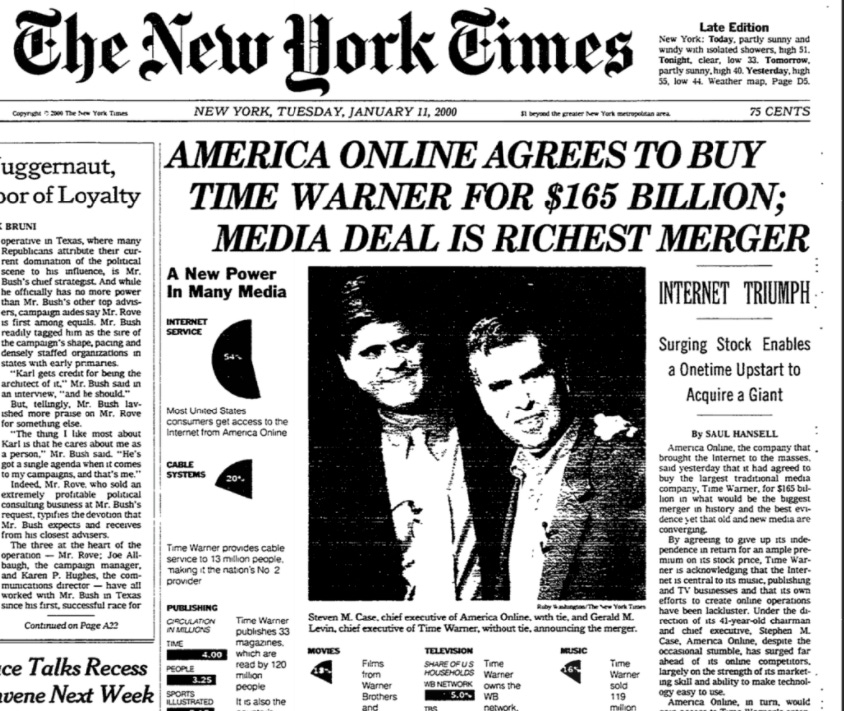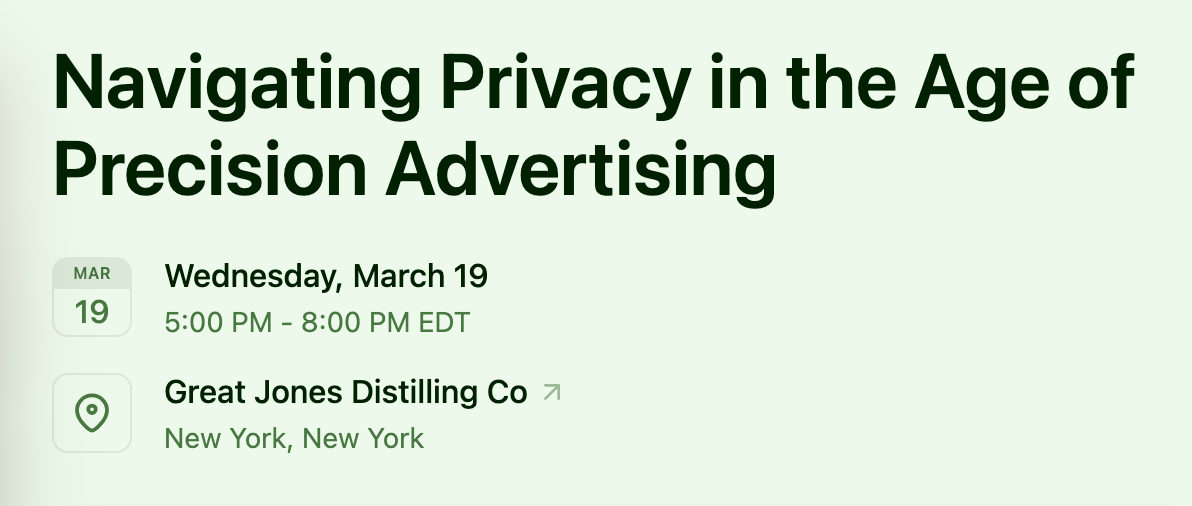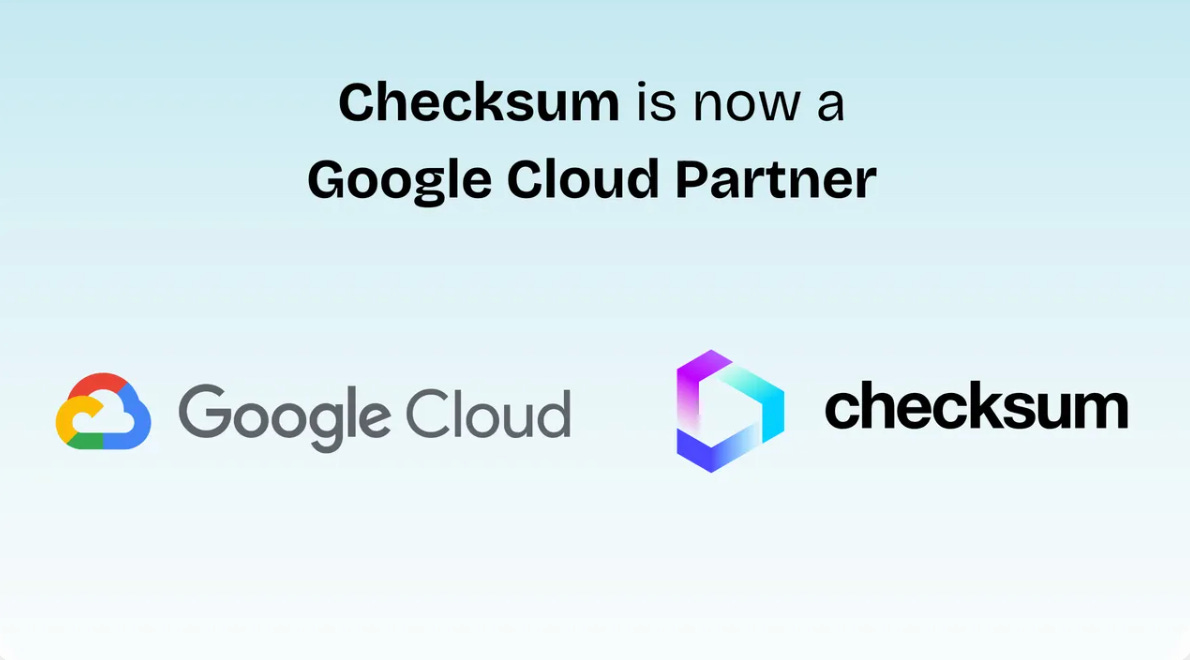The AI Arms Race Is a Head Fake
The battle for AI dominance looks fierce—but history shows us that the real opportunity lies beyond it...
This week, we’re talking:
What the portal wars can teach us about the LLM arms race. 🤔🔥
Silicon Valley and Syria—building unexpected tech bridges. 🔗💻
Spotify’s “Perfect Fit Content” sounds great—for them. But what about musicians? 🎵💰
When information is abundant, controlling the narrative is impossible. 📢🔥
Dealing with SF’s unhoused population is a serious investment — but it’s one we have to make. 🏠⚖️
Deep thinkers see what others miss—so why do we punish them instead of elevating them? 🧠⚡
The last Gilded Age had art and ideals—this one just has gold toilets. 💰🔥
My Take:
Almost 20 years ago, during the first round of the battle for dominance in consumer internet, my company landed Yahoo and Microsoft MSN as major customers. We were on the cusp of closing AOL, which had little choice but to follow its primary competitors in adopting what the market had decided was mission-critical software for pricing and predicting ad inventory. In today’s terms, it would be akin to an independent company persuading OpenAI, Anthropic, and Perplexity to adopt their technology for training or vector embedding.
Like Charlie Sheen, I thought I was winning. Turns out, I was focusing on the near-term imperative but totally missed the larger emerging opportunity.
Today, everyone is fixated on the LLM arms race—OpenAI, Anthropic, DeepSeek, and Perplexity duking it out in a winner-take-all battle for AI dominance. But history tells us that what’s happening now is just a headfake, a distraction to make you obsess over the wrong thing while the real transformation quietly unfolds in the background. The real opportunity isn’t what the giants are doing; it’s in what gets built on top of them.
Tech history has a long pattern of breathless, game-over pronouncements in the sixth inning followed by shocking upsets, twists, and turns in the ninth. Remember the Portal Wars? AOL, Yahoo, and MSN were once the beginning and end of the consumer internet. They controlled the eyeballs and the ad dollars. All of the front page articles of the Wall Street Journal and the New York Times fixated on the defenestration of their CEOs (mostly Yahoo!’s), their overpriced acquisitions (including Mark Cuban’s Broadcast.com), their no-so-secret mergers (including Microsoft’s aborted takeover of Yahoo!).
And then the whole thing blew up.
Just before the air went out of the balloon, AOL had enough clout to convince Time Warner to merge in what was later considered one of the most laughable deals of all time.
The portals soon collapsed, and the real value creation happened on top—through independent media, social networks, and platforms that didn’t depend on a portal’s homepage to drive engagement. Consumers weren’t mindless automatons forever reliant on a single company to dictate their experience. They explored, they branched out, and they chose alternatives that better suited their needs.
But if history is any guide, the next wave of AI innovation won’t be in the foundation models themselves—it’ll be in what gets built on top of them.
The same dynamic plays out over and over: big players try to gatekeep, but pesky consumers always figure out a way to dodge the troll under the bridge. Greater value accrues on top.
Same thing in enterprise. Microsoft and Intel ran the table for years. But what looked like an unbreakable duopoly turned out to be ephemeral. Linux, open-source, and cloud computing came along and changed the game, creating hundreds of opportunities for enduring software companies (Oracle, Salesforce, ServiceNow, Workday, Snowflake, Atlassian, many others) and thousands of opportunities for newer entrants to innovate and compete. Amazon appeared to be a monopolist in cloud infrastructure for the better part of a decade before Microsoft Azure and Google GCP got their act together – offering more choices for companies in search of cloud infrastructure at better prices.
Unlike the portals of two decades ago, these cloud infrastructure providers are durable, growing, and generating free cash flow. But the opportunities to build on top of them are far more voluminous and far more valuable.
Right now, the LLM space feels eerily similar to those past, too-soon-to-call-it-wait-for-it episodes. Let’s call it the LLM Wars. OpenAI, Anthropic, DeepSeek, and Perplexity are the new AOL+MSN+Yahoo, or perhaps the new AWS+Azure+GCP. They command the hype, the investment dollars, the regulatory scrutiny.
But if history is any guide, the next wave of AI innovation won’t be in the foundation models themselves—it’ll be in what gets built on top of them.
So what exactly does this next phase look like? It’s all about orchestration.
In practical terms, orchestration is about democratizing AI and making it useful on a larger scale. It’s the connective tissue that turns raw data and proprietary models into real-world solutions. Instead of treating LLMs as monolithic black boxes, orchestration:
Breaks tasks into subtasks and assigns them to the right AI tool, preventing lock-in with a single monolith (which would be incapable of solving every problem across every domain in any case).
Uses proprietary data to fine-tune models for specific industries and workflows.
Segregates enterprise data from LLMs to stave off leakage and protect proprietary data.
Optimizes cost performance, ensuring that expensive LLM calls aren’t used when a simpler model could do the job just as well.
At super{set}, we’ve been betting on this and executing our buildouts accordingly. Take Boombox, for example. It’s not just another LLM wrapper; it’s an orchestrator for music creation.
It blends large language models with non-LLM tools like melody generation, BPM detection, and WAV-to-MIDI conversion.
It learns from musicians’ actual workflows—annotated lyrics, sample libraries, past compositions—to make recommendations that are contextually relevant.
It keeps the human in the loop, making AI a collaborator rather than a replacement.
This is orchestration in practice: taking an existing model, layering in proprietary data, adding modular AI capabilities, and delivering a practical, domain-specific solution that a standalone LLM could never provide.
Don't take my word for it; proof points are everywhere. NVIDIA didn’t buy Run:AI because they think foundation models are the final answer. They bought it because they see what’s coming: a world where enduring value isn’t in the raw model, but in how models are applied, orchestrated, and optimized. A further strategic advantage for NVIDIA is to understand, via Run.AI, how LLMs leverage NVIDIA chipsets in different ways to generate application-level results.
From this perspective, Jensen’s acquisition is especially prescient. It harks back to Andy Grove, Intel’s charismatic CEO, who prodded his senior managers in the 90’s to know more about the end market for personal computing where its chips were deployed (at the time, by large players like Dell, HP, and Gateway) than any of those OEMs could possibly know themselves. If NVIDIA can continue climbing the stack in this way and staying out of the dungeon as ‘just a chipset provider,’ its AI dominance could continue well into the next decade.
For technologists thinking about how to participate professionally in this new era of AI, I’d urge you to study that decision and seek job opportunities on top. Sure, there is intellectual nourishment in building a foundational LLM (somewhat ironically, as no one, including their inventors, truly understands how or why they work). But if you fixate on the near-term imperative, you run the risk of making the same mistake I made and missing the larger emerging opportunity. Whatever your function, I recommend you put your craft to work taking advantage of these AI tools in the service of solving real problems for real people. You’ll find a lot of joy – and considerable economic opportunity – in attacking its puzzles.
The story of technology is a long-term competition in creating and climbing the next layer of the stack to build efficiently on top of what came before. Time and time again, those who declare the winners too quickly and the implacable dominance of fleeting oligopolies eat their words, or pray that the rest of us forget their earlier, breathless pronouncements.
If you’re obsessing over the LLM leaderboard—who’s got the biggest, baddest model—you’re missing the main event. The companies that win won’t be the ones making bigger models with five trillion parameters instead of just two. They’ll be the ones making AI useful by abstracting away LLM complexity and enabling businesses to focus on outcomes. Orchestration is how that happens.
Early birds sometimes get worms, but the second mouse gets the cheese.
My Media Diet This Week:
Syria just hosted its first international tech conference in 50 years by Danny Maki via rest of world
The two-day SYNC 25 conference, organized by a group of Syrian-Americans working in Silicon Valley, included workshops and discussions on artificial intelligence and data security, among other tech-related topics. The program aimed to connect Silicon Valley with Syria’s emerging tech ecosystem.
The Ghost in the Machine: Spotify’s Plot Against Musicians by Liz Pelly via Harper’s
Spotify, I discovered, not only has partnerships with a web of production companies, which, as one former employee put it, provide Spotify with “music we benefited from financially,” but also a team of employees working to seed these tracks on playlists across the platform. In doing so, they are effectively working to grow the percentage of total streams of music that is cheaper for the platform. The program’s name: Perfect Fit Content (PFC). The PFC program raises troubling prospects for working musicians. Some face the possibility of losing out on crucial income by having their tracks passed over for playlist placement or replaced in favor of PFC; others, who record PFC music themselves, must often give up control of certain royalty rights that, if a track becomes popular, could be highly lucrative. But it also raises worrying questions for all of us who listen to music. It puts forth an image of a future in which—as streaming services push music further into the background, and normalize anonymous, low-cost playlist filler—the relationship between listener and artist might be severed completely.
The book was called “The Revolt of the Public,” and it described how politics was changing because media and information had gone from scarce to abundant. This new informational dynamic creates constant recurrent crises for whoever is in power: The ability to control a narrative is gone. And in this world of fractured media, there is always an incentive and ability to show what is wrong with whoever is in power.
Her job is to remove homeless people from SF’s parks. Her methods are extraordinary by Susan Freinkel via SFStandard
A welter of problems can make someone chronically homeless: addiction, mental illness, disabilities, trauma, poverty, not to mention failures of the system. None are easily or quickly solved, even after the person is housed. To do more than just clear a person off the sidewalk demands persistence, patience, coordination of services, and intense personal engagement. Which raises the difficult question: If this is what it takes to help one person, can the city find the resolve to help the thousands living rough?
The Coming Collapse: Sensitivity Will Determine Survival
Neuroscience tells us why. Highly sensitive individuals show deeper processing in the default mode network, the system responsible for constructing meaning and perceiving patterns (Raichle, 2015). Their brains don't compartmentalize neatly. Instead of isolating memories, facts, and observations, their neural networks maintain cross-hemispheric integration—allowing them to reach insights others suppress as irrelevant noise (Jung et al., 2013). Society isn't designed for this kind of thinking. It systematically destroys deeper perception through a process that creates measurable neural damage. McEwen's research shows how chronic suppression of natural pattern recognition physically alters brain structure, particularly in regions responsible for complex analysis and integration. When human minds are forced to choose between speaking their deeper understanding and facing rejection, or silencing themselves and facing internal fragmentation, the biological cost is severe.
The Gilded Age Never Ended by Adam Gopnik via The New Yorker
Every modern age is known by the medievalism it spawns. The first Gilded Age swooned over the melancholy maidens and poesy-minded, grail-seeking Galahads of Tennyson’s “Idylls of the King,” and so it is perhaps striking that our own medievalist saga, the “Game of Thrones” cycle on television, with its spinoff and its knockoffs, is notably more brutal and less aesthetic than any that has come before. When the most beautiful church in King’s Landing blows up, all we see is Queen Cersei, celebrating sneeringly with a glass of wine. The same brutal philistinism of the new Gilded Age as we have come to know it—that of Trumpism, as of the Putinism it admires—is essential to its ideology: there is only power and domination, dragons and destruction, and anything more is a fool’s deception. Hierarchies of power are intrinsic to human societies, no doubt, and sometimes the best we can hope for is that those on top become devoted to a higher ideal of education or common welfare or simple beauty. Without that impulse, we live in a truly barren time. Golden is better than gilded, but even gilt is better than iron.
From the Hive:
How are leading media and entertainment companies innovating in targeted advertising while navigating an evolving privacy landscape? Join us for an intimate panel and networking hour as experts from privacy, tech, and digital spheres explore the sophisticated tools and frameworks shaping digital advertising today. Through focused panel discussion and peer networking, we'll examine emerging technologies, compliance strategies, and practical approaches to building effective, responsible advertising programs.
Designed for professionals at the intersection of privacy, marketing, and technology who want to stay ahead of industry developments. Hosted by Myna Partners and Ketch. You can register here.
🥳🥳🥳 Checksum AI is now available on Google Cloud Marketplace after successfully graduating from the Google Cloud Emerging Partner Springboard Program. This milestone marks a significant step in the Checksum AI journey to revolutionize AI-powered end-to-end testing solutions, making them more accessible, scalable, and efficient for businesses worldwide.









